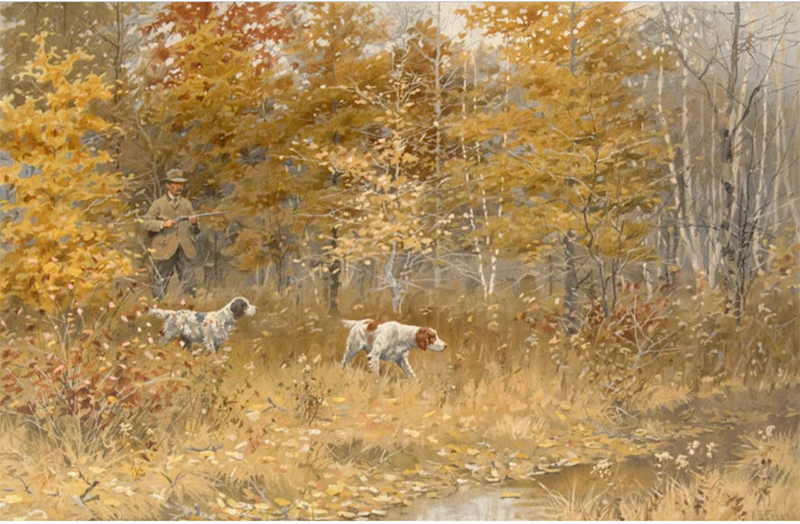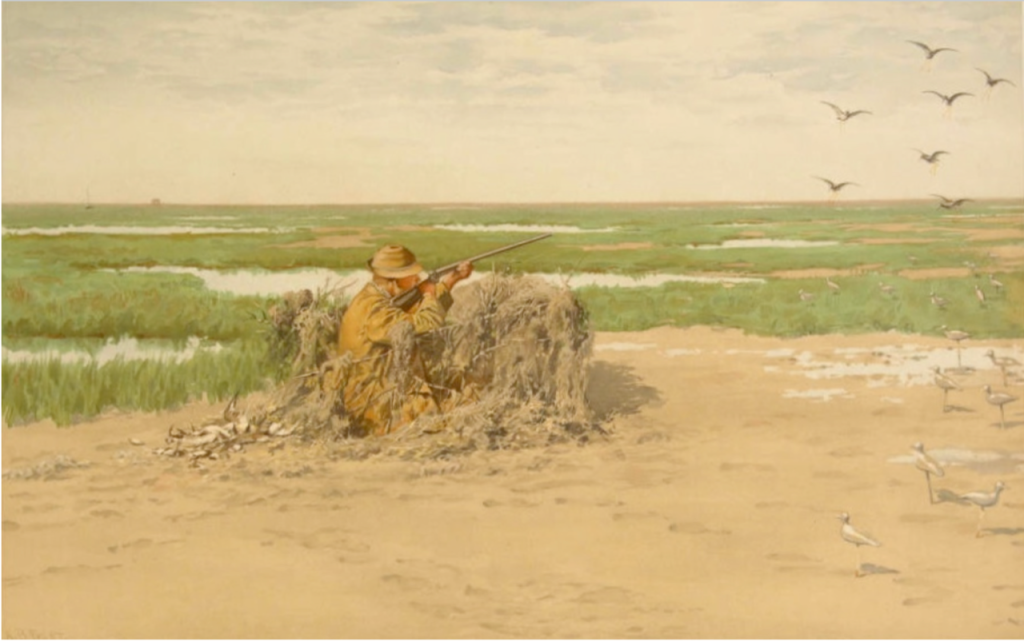
by Brooke Chilvers
Luckily, there are still walls in public places—or at least in lawyers’ offices and executive boardrooms—suitable for sporting prints that depict, well, men with side-by-side shotguns and hunting dogs, on the threshold of pulling the trigger on nervous quail, shy rails and rabbits, grouse, geese, and such. Almost one hundred years after the death of artist Arthur Burdett (A.B.) Frost (1851–1928), sportsmen continue to seek his timeless images of the good life on the East Coast, when gentlemen’s sport in wild places was available close to home.
In addition to his long career as illustrator to some of America’s greatest magazines, especially Harper’s Weekly, Scribner’s Monthly, Collier’s, and Life, Frost’s three costly portfolios of sporting art created lasting images in the American conscience of our outdoor heritage. Even though the majority of Frost’s output, estimated at some 10,000 drawings, oils, and watercolors, produced at a pace of roughly 200 per year, was reproduced in black and white, sometimes washed with sepia, the harmony of his hues in the goldening autumn landscapes—of woodcock and shorebird sheltering saltmarshes—are instantly recognizable.

Mostly self-educated, Frost was projected into success in 1874 when the satirical book he illustrated, Out of the Old Hurly-Burly or Life in An Odd Corner, by Charles Heber Clark under the pen name Max Adeler, sold more than one million copies. Frost went on to illustrate some 90 books, including titles by Lewis Carroll, Charles Dickens, Mark Twain, Theodore Roosevelt, and William Thackery. In addition to his own three “masterpieces of comedy,” including Carlo (1913), the tale of an accident-prone adopted pet, Frost brought to life all the familiar characters in eight “Uncle Remus” books by folklorist author Joel Chandler Harris; Br’er Rabbit and Br’er Fox, Tar-Baby and all, are with us still.
In 1895, the publication of Frost’s portfolio, Shooting Pictures, by Charles Scribner’s Sons, with 12 chromolithographs and 40 line drawings of upland and shorebird hunting, brought him fame as America’s favorite sporting artist. Although the individual prints, originally sold by subscription, are considered “rare and desirable,” complete sets, counting 43 separate pieces within the large (18⅞ x 26¼ inches) dark red, half Morocco Solander case are very rare, indeed. Complete collections consist of six sets of two approximately 13 x 20-inch prints in full color on thick card mounts, each accompanied by a large leaf of letterpress text in two columns, decorated with three related pen-and-ink line drawings; each set was wrapped in heavy gray paper.

The text, written by industrialist and sportsman Charles D. Lanier, describes each classic hunt.
The twelve titles are: Rail Shooting; Bay Snipe; Autumn Grouse Shooting; Summer Woodcock; English Snipe; Prairie Chicken; Ducks from a Battery; Ducks from a Blind; Rabbit Shooting; Quail—Dead Stand; Autumn Woodcock, and Quail Shooting.
Described as having the “impractical format” of 19 x 16.5 inches, the Boston printing of 2,500 never-reprinted copies is considered of adequate quality for their then-price. The Philadelphia Print Shop notes of the harmoniously colored collection, “The use of the lighter, French style of chromolithography enabled the prints to capture the warmth and richness of the original watercolors.”
